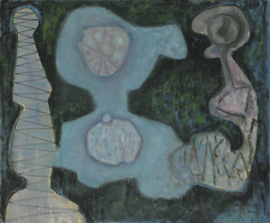Today’s post comes from Samantha Moyer, Art Center docent.
The perspective of a museum curator is always a very interesting one to gain insight about; so I was very pleased to be able to interview Patricia Phagan, curator of the currently running special exhibition A Taste for the Modern, this week for the Lehman Loeb blog. Her responses to a few questions below help in understanding the task of creating a show and her personal experience with this exhibition.
Question: Are you yourself particularly a fan of modern art, why or why not? How did that influence your experience when working with this special exhibition?
Patricia Phagan: I am a big fan of modern art. Though I have just finished a study of Thomas Rowlandson, an eighteenth-century social satirist, my Ph.D. in art history is actually in twentieth-century art, and that means painting and sculpture as well as prints and drawings. I was elated to be given the opportunity with this new exhibition to work with modern painting and sculpture. They have a physicality and spirit that I find invigorating.
Question: Of the three alumna donors, Blanchette Hooker Rochefeller, Virginia Herrick Deknatel, and Edna Bryner Schwab, do you have a favorite collector?
PP: I don’t have a favorite, actually, among the three collectors. I enjoyed working on the histories of all three private collections. Each one was at first a puzzle–an intellectual puzzle–that needed sorting out and documenting with research and family interviews.
Question: Each of the alumna donors gave many more works of modern art to the Loeb than are on display in the A Taste for the Modern special exhibition; how did you choose which pieces to include in this show?
PP: The exhibition presents major representative works from each of the three collections. Several works not in the exhibition are displayed in the twentieth century galleries. I was pleased to have special labels that identify those works in the twentieth century galleries given by the three collectors.
Question: When displaying pieces of art, what thought process do you use to decide which pieces should neighbor one another?
PP: In designing a show, I try to place very important works in the center of a wall and at the end of a vista. Then I usually work out from the center of the wall, gathering conceptually related works on either side, and keeping in mind the style and size of the frames. Then I try to make a pleasing tension with the lines and shapes of the frames against the shapes and colors of the works themselves. An interesting rhythm or pace in an installation is essential for me.





